Guest blog by Killian Mullarney and Oscar Campbell

Introduction
The OSME region is not short of bird species that present those of us who like an identification challenge with something to get our teeth into, ranging from Aquila eagles and grey shrikes to the dreaded Lesser Whitethroat tangle. Much progress has been made with most of these issues over recent decades, but one species-pair has defied efforts to gain clarity, the common, widely distributed Little Tern and the far more localized Saunders’s Tern, which is very much an Arabian specialty in the summer months. While some criteria for identifying birds in summer plumage were worked out long ago, immature and winter plumages have generally been regarded as virtually inseparable.
In a paper published recently in Dutch Birding, we present a radical new perspective on the problem. In addition to reviewing and expanding on the established criteria for identifying adults in summer plumage, we put forward a number of ‘new’ features that enable birds in juvenile and winter plumage to be identified; surprisingly, these are even more readily identified than birds in summer plumage! We also discuss the implications for the relative status of both species in OSME waters and further afield across the Indian Ocean. As this is an identification issue that many birders resident in or visiting Arabia will grapple with, we thought it would be useful to summarise some of the key separating characteristics for the two species in this short article and to suggest implications for their relative distributions away from the breeding grounds. There is now great scope for birders on both Arabian coastlines and beyond to elucidate the true status in the non-breeding season of these two misunderstood species. Anyone with a serious interest in this subject, especially if they operate within the range of Saunders’s Tern, should read the full paper published in Dutch Birding 44: 165-198, which contains almost 60 captioned photographs and three colour plates.
Summary of identification features
Key characteristics that can be used to separate adults (summer and winter) and juveniles are outlined below. The difference in secondaries that we describe – essentially a broad, whitish triangular area on the rear of the wing, as opposed to a well-defined white trailing edge – may be difficult to ascertain in flight views, but can often be reliably determined in photos, even in distant ‘record-shots’. Care needs to be taken, however as some Little Terns (usually more worn birds, in winter, but at other times a momentary impression more likely to be captured by the camera than register to the eye) can show an irregular white patch on the secondaries, not unlike the feature we describe in Saunders’s Tern.
| Saunders’s Tern | Little Tern | |
| Pattern of secondaries | No well-defined trailing edge. Instead, a rather broad, diffuse whitish area that spreads into the greater coverts, which are almost as pale. | Well-defined but narrow white trailing edge to all secondaries; grey of secondaries concolorous with rest of coverts. |
| Upperpart and rump coloration | Pale pearly grey, contrasting strongly with the very blackish outer primaries. However, no strong contrast with the rump, which is similarly tinged pale grey. | Rather darker, slightly blue-tinged or leaden-grey, contrasting less against dark grey outer primaries. However, usually a strong contrast with contrastingly white rump. |
Other features, already well-described in the literature, in particular head pattern and leg colour, are highly indicative and can be used reliably, although require good views and care. However, formerly much-quoted features such as number of dark outer primaries or primary shaft colour are too subject to overlap and so difficult to confidently ascertain that they should be regarded as quite unreliable.
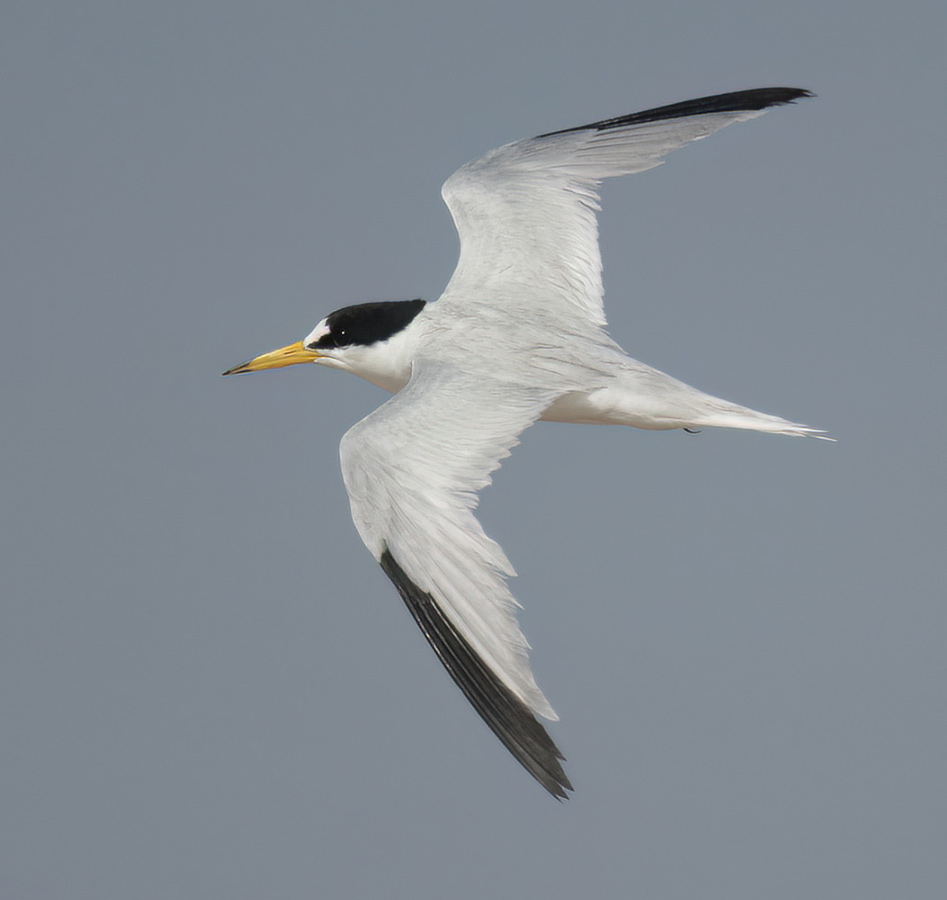
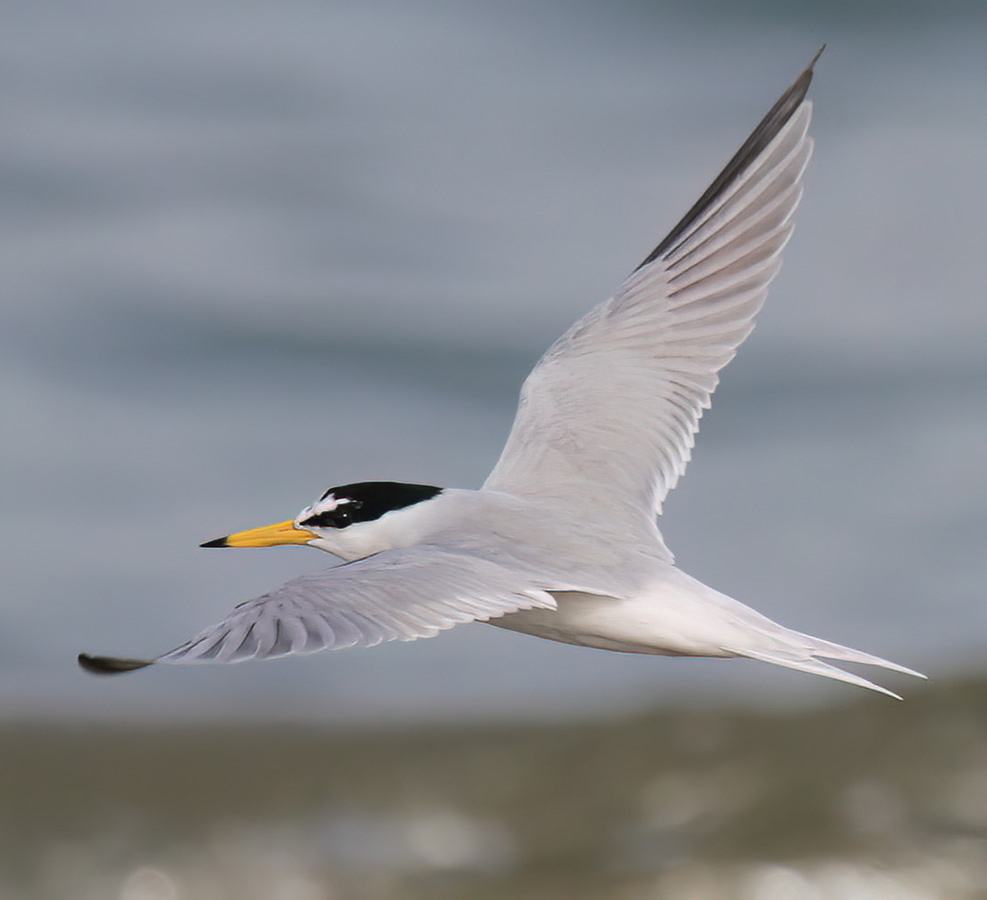
Summer plumage – Left: Saunders’s Tern, May 2021 (David Darrell-Lambert); Right: Little Tern, UAE, May 2009 (Tommy Pedersen).
Winter plumages
| Saunders’s Tern | Little Tern | |
| Pattern of secondaries | As adult summer – secondaries almost all whitish, merging into outer greater coverts and so forming a broad, white border to the rear wing. | As adult summer – grey secondaries with narrow white tips forming a narrow trailing edge. Some have white lines running through the dark grey, in a ‘venetian blind’ pattern. |
| Impression of upperparts and rump in flight | Overall a pale, tricoloured wing: pale, pearly grey coverts and saddle, outer primaries and carpal contrastingly dark (blackish) and broad whitish border. Rump very pale. | Overall a rather subdued, bicoloured wing: leaden-grey (often darker than in breeding plumage), with limited contrast against darker grey outer primaries and, often, a uniform, dark grey rump. |
| Head pattern | Mainly white-crowned with very limited grey shading or streaking, mainly to the rear. Distinctly ‘masked’ appearance (resembling Black-naped Tern!). Lacks short white eyebrow. | Crown streaked and shaded grey, leaving white forehead with invariably short white eyebrow (mirroring the pattern of summer plumage). |
Although (as we came to realise during the course of this work!), neither of us has actually seen a winter-plumaged Saunders’s Tern in the field we suggest that the difference in head pattern is much more readily discernible in winter plumage than in summer. Furthermore, Saunders’s never gives the ‘uniform grey above, almost Whiskered Tern-impression’ typical of the Sternula wintering on Arabian coastlines – that’s because these birds are all Littles!
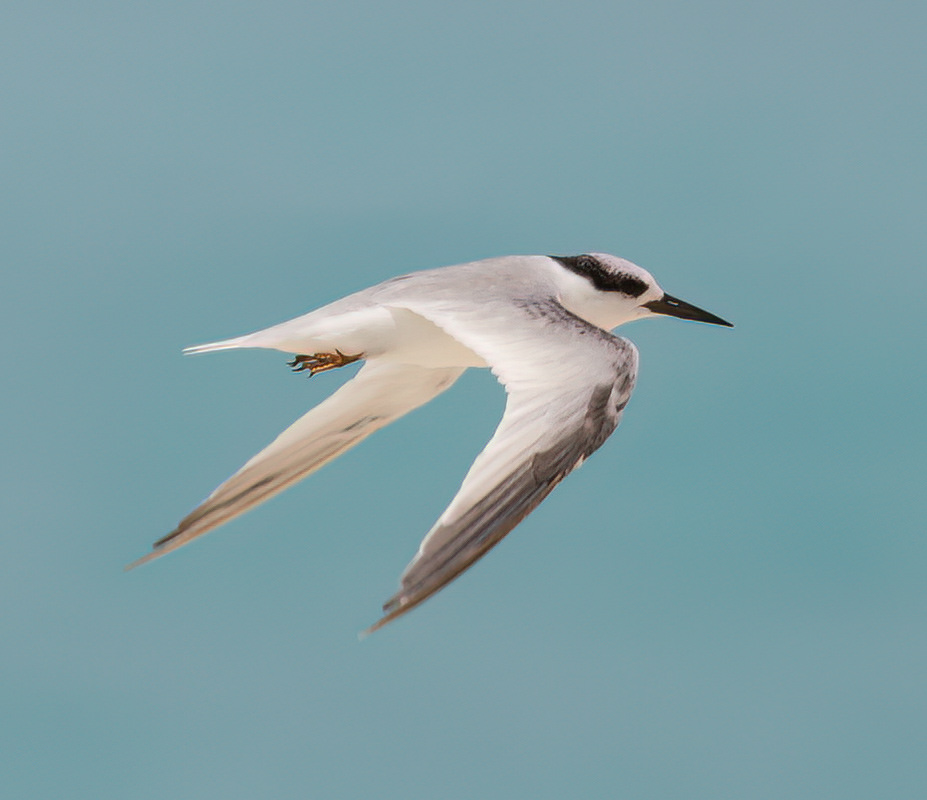
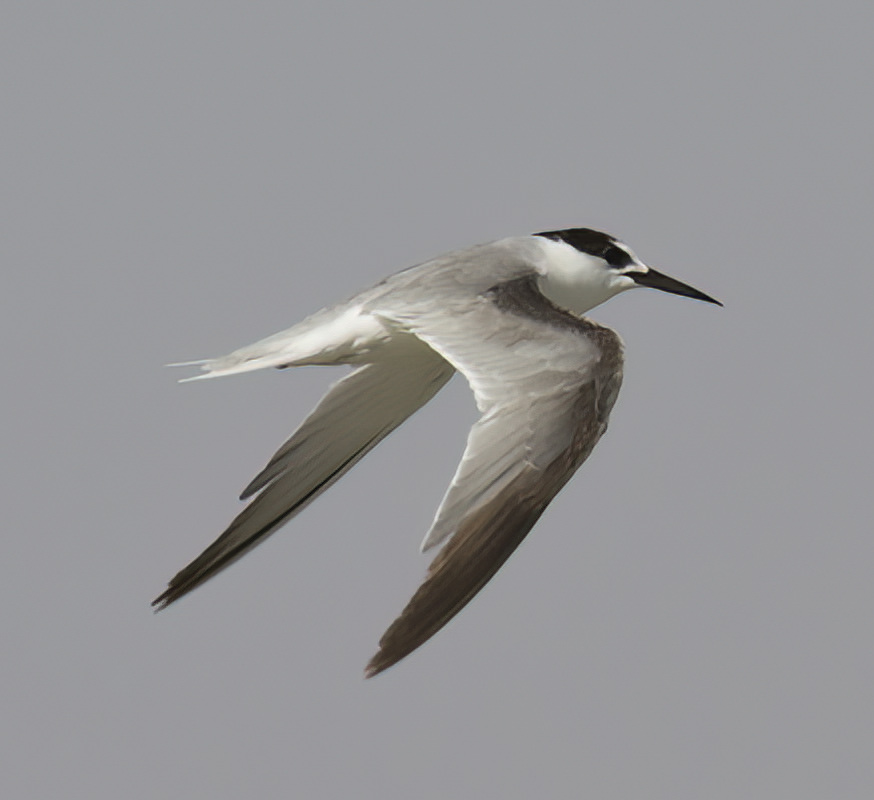
Winter plumage – Left: Saunders’s Tern, December 2011, Seychelles (Stewart Smyth); Right: Little Tern, Oman, November 2017 (Steve NG Howell). Note the broad and more diffuse white area on the rear of the wing in the Saunders’s, compared to the narrow white tips to the secondaries forming a distinct trailing edge. The Little Tern has slightly darker grey upperparts than the Saunders’s and lacks the extensive white crown of Saunders’s.
Juveniles
The wing-pattern of juvenile Saunders’s in flight is so striking that even birds at long range can be confidently identified.
| Saunders’s Tern | Little Tern | |
| Pattern of secondaries | Even more striking than in adult; all whitish, as are inner primaries and much of greater coverts, so forming a large, obvious triangle on the rear wing. | Essentially plain and grey; may appear to have a paler area on rear wing, but much less striking than in Saunders’s, especially when viewed at close range. |
| Outer primaries | Very dark, virtually blackish, and contrasting strongly with inners and secondaries – overall effect is almost Sabine’s Gull like! | Darker grey than rest of wing (except carpal) but not strikingly so; entire wing looks more much subdued than on any Saunders’s. |
| Head pattern | Variable; often somewhat paler than Little on crown and rapidly moulted to characteristic adult winter pattern. | Much as adult non-breeding; rather darker on forecrown when very young but hint of white eyebrow present. |
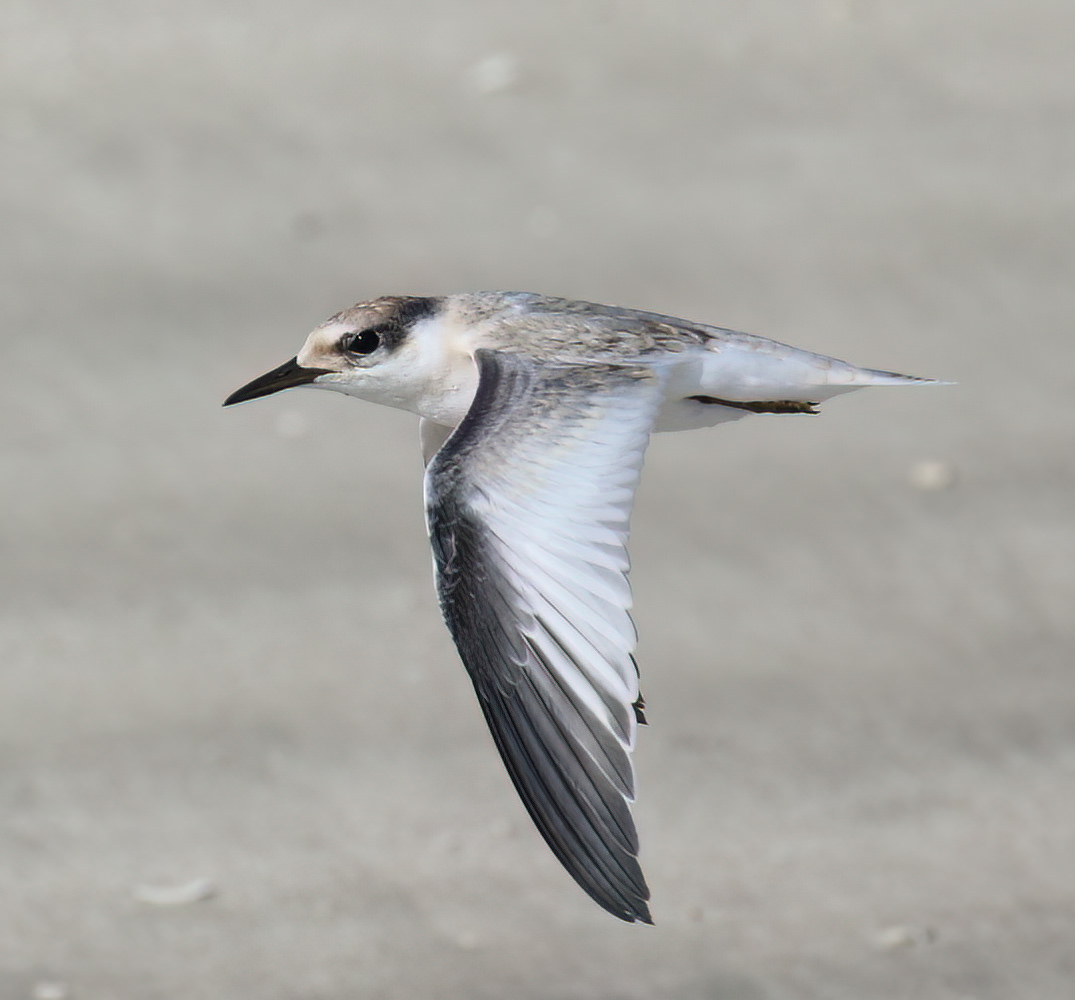
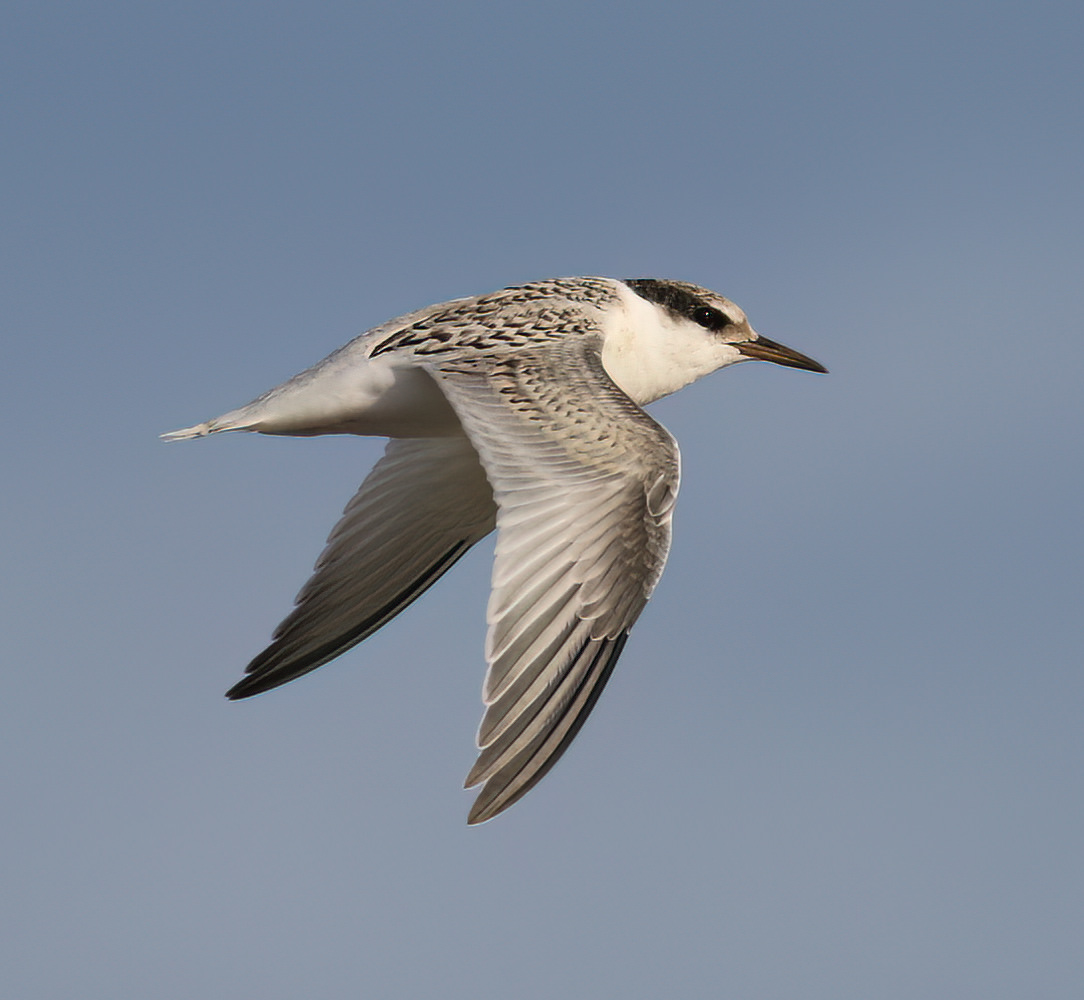
Juveniles – Left: Saunders’s Tern, May 2021, UAE (OC); Right: Little Tern, July 2021, Ireland (KM)
Distribution outside the breeding season
The above field characters were tested against hundreds of Sternula on UAE shorelines during the course of 2021 and 2022 and against many dozens of images from the UAE online. The results were stark; Saunders’s is virtually non-existent outside the period late February to late July (or August?) in the UAE waters. Looking at images taken in autumn and winter of birds from elsewhere around the Arabian coastline, and from East Africa revealed the same – whilst we cannot say that Saunders’s is totally absent (many countries had very few images of any Sternula archived online), all the birds identifiable were Littles, despite Saunders’s being popularly believed to be the default species in, e.g. coastal Kenya. Images of Saunders’s were very rare (but not totally absent) from western India too. The only place we found Saunders’s Terns to be numerous in the non-breeding season were the Maldives and outer, coralline Seychelles Islands (but not the inner granitic islands – the Sternula images we saw from there, one from Reunion, and almost all from Madagascar were Little). This implies a very different range and habitat choice during the non-breeding season. It may also imply that Saunders’s Tern is much less numerous globally than is currently appreciated, and its conservation status may require a review. We would be delighted if birders in the OSME region and beyond could investigate the true status of Saunders’s Tern outside the non-breeding season; we hope this short article, and the paper it is based on, will give them the incentive and means to do so.
Acknowledgements
Our work on Sternula terns was started in preparation for the 3rd edition of the Collin’s Bird Guide (published this year) and will be incorporated into the 3rd edition of Birds of the Middle East, to be published in 2023. The large number of colleagues, photographers and friends who helped us in the 18 months that we worked on Saunders’s and Little Terns are fully acknowledged in the Dutch Birding paper this summary is based on; in addition, we thank Steve NG Howell for subsequent correspondence and provision of images, one of which we include here. We would also like to extend a sincere thank you to the editorial team at Dutch Birding, in particular André van Loon, Roland van der Vliet and Enno Ebels, who worked hard over many months on our paper, and for agreeing to our preparing this online summary. The paper will be available made online by Dutch Birding in due course at https://www.dutchbirding.nl/journal.
About the authors
Killian Mullarney, is an Irish birder here pictured in the garden at Easington, Spurn in September 2021, where England’s first Siberian Accentor was found. Unfortunately, his visit was five years too late. He is perhaps best known as a co-author of the very popular Bonniers/Collins Bird Guide, published in over 20 different language editions. Killian is also a member of The Sound Approach team and has contributed illustrations to most Sound Approach publications. He is a member of the Dutch Birding Editorial Advisory Board and a former long-serving member of the Irish Rare Birds Committee.
Oscar Campbell, here pictured at Balghelam Island, UAE in March 2015, photographing Saunders’s and Little Terns, originates from Ireland but has taught Chemistry at a school in Abu Dhabi since September 2006. He is currently a member of the Sandgrouse Editorial Board and chairman of the Emirates Bird Records Committee.


Photo credits – Tony Broome (KM) and Tommy Pedersen (OC)


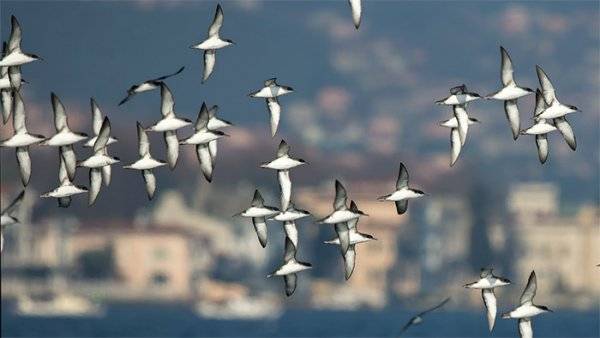
Wow nice comparison,it’s a challenge for idying in Arabian for all season.